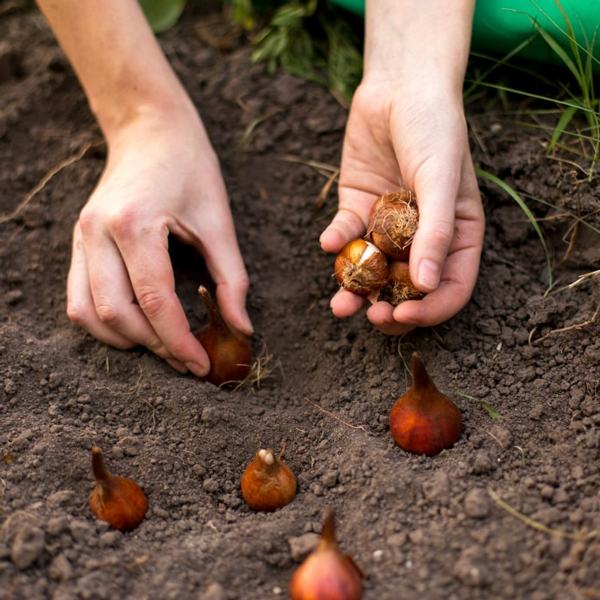Bulbs are self-contained packets of life. Enclosed within them are leaves, flower buds and the food that is necessary to provide beautiful spring blooms. For spectacular results, all you need to do is plant the bulbs in a well-drained, sunny spot.
CHOOSING BULBS
Select firm bulbs with no noticeable damage.
Select the biggest bulbs you can afford.
Purchase bulbs early in the season; they’re the freshest.
Buy larger quantities of fewer types and plant in larger groups for a stronger display.
If deer browsing is a problem, choose daffodils and crocus.
PESTS
Deer and rabbits can be fond of bulb flowers and foliage, particularly of tulips. Chipmunks can eat the bulb, itself. If you’ve had trouble growing tulips, you will have better success with daffodils and crocus which have naturally toxic leaves and bulbs that most predators will avoid. Also shunned by deer are Allium, Scilla, Chionodoxa, Eranthis, Muscari, and Galanthus.
Other strategies for outwitting pests include repellents that can be used to coat new bulbs before planting and to “taint” the planting area. Ask our horticulturists for more detailed information on foiling a specific pest.
PLANTING
Plant as soon as you buy them so that they have time to root before the ground freezes.
Depth – The general rule is to plant a bulb at a depth 2 to 3 times greater than the height of the bulb. Tulips and daffodils can benefit from being planted slightly deeper, 12” for daffodils and 8” for tulips. The greater depth discourages a bulb from splitting into smaller bulblets and encourages it to grow larger with consequently larger blossoms. Deeper planting for narcissus and tulips can also enhance persistence.
Soil – All bulbs prefer good drainage — a sandy loam is ideal. In heavy clay soils, bulbs may rot.
Fertilizer – Use a bulb booster fertilizer in the planting hole. Bone meal works as well but may attract dogs and skunks.
Grouping – Plant in groups of no fewer than 3 bulbs with two exceptions. The smallest bulbs can be planted singly but closely. “Naturalized” bulbs, often sited by tossing them into the landscaped area and planting them where they fall, can also be planted singly. When planting in large groups, dig a single flat-bottomed hole that can accommodate the group at the correct spacing; place all the bulbs at once and backfill.
Right side up? – Bulbs have slightly flattened bottoms that often show the remainder of fine roots. The tops are pointed although sometimes barely so. Orient the bulbs with bottom down when planting. Unsure? Don’t worry – the stem will grow out of the top and find its way to the surface regardless of how you plant the bulb.
FERTILIZING
Bulbs can benefit from annual spring fertilization. Too much nitrogen can make foliage floppy and weak, so we recommend using a product labeled for bulbs or any 3-5-3 or comparable fertilizer.

DAFFODILS AND JONQUILS ARE NARCISSUS?
The Latin name Narcissus refers to the entire group of bulbs for which the common names “daffodil” and “narcissus” are interchangeable; jonquils however, are a specific group of narcissus or daffodil, Narcissus jonquilla. All narcissus bulbs bloom in spring and, with a mix of varieties, provide flowers for more than two months in yellow, gold, white, orange, red, and pink. Blossoms have two major parts, the perianth or “saucer” and the corona or “cup”, often in contrasting colors. Bulbs are spoken of as having “noses” because of their distinctively pointed shape. A desirably large bulb may have several noses connected together. Growing 2-18” tall, Narcissi should be spaced 6” apart and 6-8” deep unless bulbs are particularly large, in which case they can be planted up to 12” deep. Narcissi prefer full sun. They can take part sun but their flowers will face the light source.
There are miniature, dwarf and normal sized cultivars that fall into eleven categories: trumpets, both small- and large-cupped; doubles; triandrus with more than one flower to a stem; cyclameneus with a reflexed perianth; jonquilla which are usually fragrant; tazetta with many fragrant blossoms in a cluster; poeticus with a large white perianth and small cup, late blooming; species and wild forms; and a catch-all category for others such as “Split Cups” that are not easily classified.
Paperwhite Narcissus are a form of highly scented daffodil that can be easily forced without a chilling period and are, consequently, very popular for indoor display from December to March.
TULIPS
Tulips, botanically named Tulipa, come in all colors except for true blue and range in height from 4-30”. Plant them 3-6” apart and cover with 4-6” of soil. Tulips planted slightly deeper may be more likely to persist or even perennialize. Among the types, the species and lily-flowered are the most persistent. In general, however, tulip plantings should be completely replaced every three to four years. Tulips prefer full sun or light, bright shade. Like all bulbs, they need good drainage. If more than one type of tulip is planted, the bloom season can cover 6 to 8 weeks. The following is a partial listing of the many types given in order of bloom time.
species – not hybridized, usually smaller and sometimes clustered flowers; bloom time varies, but most are very early.
- griegii – a species tulip with variegated or marbled foliage, a relatively large flower for a species tulip, very early spring.
- kaufmanniana – low growing species tulip with large flowers, very early spring.
- fosteriana – a species tulip and parent of many Darwin Hybrids, includes the “Emperors”, very early spring.
Single Early – often used for forcing, used in beds and borders, hardy, early spring.
Double Early – double blossoms, early spring.
Triumph – derived from crossing Single Early tulips with late May- flowering and Darwin varieties, mid spring.
Darwin Hybrids – created by crossing Darwins, to give a tall stem, with Tulipa fosteriana which gives earlier bloom than regular Darwins, usually single, usually solid colors, late spring.
Lily-flowered – with pointed petals giving an upright, lily shape, late spring.
Parrot – large flowers with twisted, cut, often multicolored petals, late spring.
Fringed – a subgroup of the parrots; similar to parrot but without the green markings, late spring.
Double Late or Peony-flowered – flowers look almost like small peonies, actually a double Triumph, late spring.
Single Late – late spring. - viridiflora – a streak of green on each petal, most are mutations of Single Late tulips so most flower in late spring.
Specialty – bloom time varies, although many of these are species and early blooming.
Darwin – large cup-shaped flowers with tall stems; the most popular type with the most new varieties introduced every season, late spring.
“MINOR” BULBS
There are hundreds of genera of bulbs, with Tulipa and Narcissus being the most commonly used. All the rest are often called the “minor bulbs” although they can have major impact in the landscape.
Allium, related to the edible onion, spring to summer for 1 month, 6” to 5’ tall, white/purple/mauve/pink/blue/yellow, space 6-12” apart and three times depth of bulb, usually the full sun.
Anemone, spring and summer, 2-15” tall, blue/white/pink/rose/mauve/terra-cotta, space 4” apart and cover with 1-2” of soil, full sun or filtered shade.
Camassia (Quamash), spring for 1 month, 2-3’ tall, lavender/blue/white, space 6” apart and cover with 3” of soil, full sun to light shade
Chionodoxa (Glory-of-the-snow), early spring for 1 month, 6” tall, blue/white, space 1-3” apart and cover with 2” of soil, full sun to light shade.
Crocus are popular for planting in beds as well as naturalizing in grassy areas, fall or spring blooming types, 3-5” tall, lavender/purple/white/yellow/orange, space 4-6” apart and cover with 2-4” of soil, full sun.
Eranthis (Winter Aconite), early spring for 2 months, 4” tall, yellow/gold, space 4” apart and cover with 2” of soil, full sun to light shade.
Erythronium (Trout Lily, Dog-tooth Violet) perfect for woodland, marbled foliage, spring for several weeks, 6-24” tall, white/yellow/lilac/pink/purple, space 6-12” apart and cover with 2-3” soil, medium shade to light shade.
Galanthus (Snowdrop), first bulb to flower — sometimes through the snow — for several weeks, 4-9” tall, white, space 3” apart and cover with 2-3” of soil, light shade.
Hyacinthus (Hyacinth), formal, heady fragrance, can be forced in water, spring for several weeks, 8-12” tall, white/pink/blue/mauve/rose/red/purple/tawny orange, spacing 6” apart and cover with 5” of soil, full sun to light shade.
Iris (Dutch Iris), early spring, 12-15” tall, all colors except true red, space 2-8” and cover with 3” of soil, full sun or light shade.
Leucojum aestivum (Spring Snowflake), arching bells in mid to late spring, 4-6” tall, white/pale pink, space 2-4” apart and cover with 1-2” of soil, light shade.
Muscari (Grape Hyacinth), deer resistant, spring for 1 month, 6-9” tall, blues/white, space 3” apart and cover with 2-3” of soil, full sun to part shade.
Ornithogalum, mid-spring for several weeks, 12-30” tall, white/rarely yellow or orange, space 3-4” apart and cover with 1-2” of soil, full sun to part shade.
Oxalis, late spring for a long period, only a few are hardy in our area, 4-12” tall, white/pink/lavender/rose/yellow, space 2-6” apart and cover with 1” of soil, full sun.
Scilla (Squill, Bluebell), early spring to late spring for several weeks, 6-12” tall, blue/white/pink/lavender, spacing 6-8” apart and cover with 2” of soil, filtered shade.






